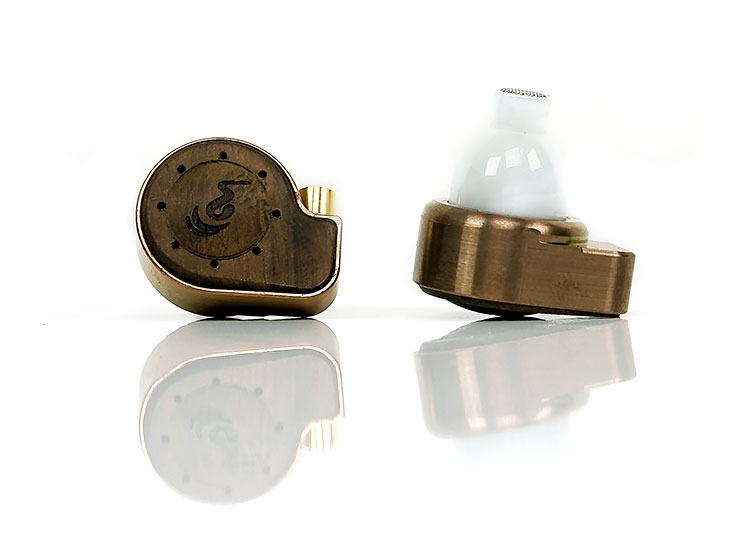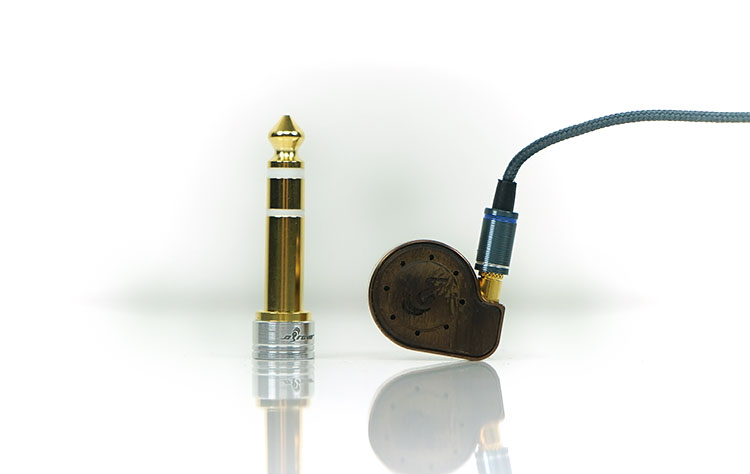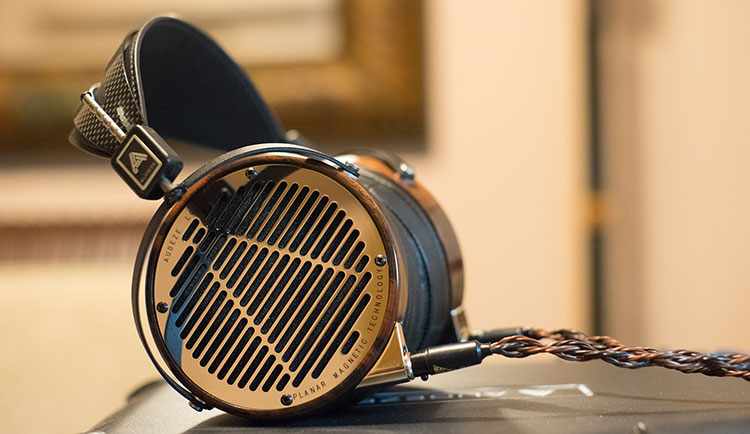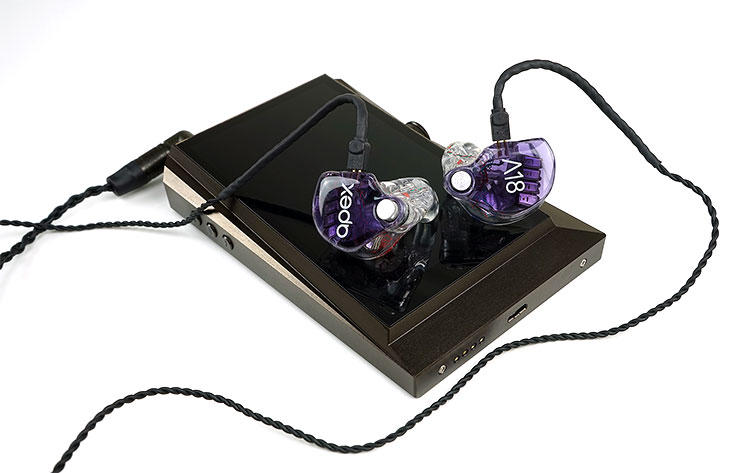Select Comparisons
Obravo Ra C-Cu
$9999
Technical
The Ra is a hybrid single neodymium 16mm driver combined with an AMT II tweeter with a crossover point of around 7-8k. It is also semi-open but not quite as open in design as the LCDi4. The LCDi4 is planar magnetic with the ultra-thin film diaphragm over a 30mm single driver. It uses their Fluxor magnet and Uniforce technology and is pitched as a mini-LCD-4. These are two very different designs but both claim to be able to take the place of your regular headphone.
Build
The Ra follows a much more traditional IEM design compared to the striking LCDi4 form factor. As such I would consider the RA to be more of an IEM in terms of look and feel than the LCDi4. The build materials are also a little more opulent than the more industrial but refined look of the magnesium alloy framed LCDi4. You get a mix of ceramics, a semi-open Acacia wood plate on top of a very finely contoured copper chassis. It is heavier than the LCDi4 as a result
Cables
Both have detachable cable systems with the Ra using a modified MMCX and the LCDi4 using a 2-pin 0.78mm but both have quirks. The Ra’s MMCX connectors are circular and deep meaning regular MMCX pins will not fit into the Ra. The LCDi4 will take thinner barrels but they have to be inverted and run straight down meaning some aftermarket cables are awkward in their application.
The oBravo stock cable is just average, they could do better on this one though they do offer both single-ended and balanced. The LCDi4 cable is much better quality though I would love to see a 2.5mm and 4.4mm option.
The Ra is a little fussier with tips compared to the LCDi4. However, the LCDi4 is less comfortable to wear due to the hook system. I would recommend asking Snug from the UK to make you a nice set of custom tips for the Ra, it makes a huge difference. For the LCDi4 the spiral tips and smooth tips work just fine and there is really no need to mess about with them.
Packaging & Accessories
The packaging and accessory line-up for the Ra is sublime and every bit as OTT as you would expect for the price point with the matching little and large Acacia display cases and Comply tip selections. The LCDi4 packaging is strong, possibly a bit more portable and useful n that respect than the Ra line-up but not quite as extravagant and show-case worthy.
Performance
Unlike the oBravo Ra, the matchability of the LCDi4 is less of a studied journey and more of “pick what you like the most”. You are far more likely to get an enjoyable pairing with the LCDi4 than the Ra which is super fussy. The LCDi4 has a more forgiving sound signature and more responsive to EQ and DSP. The LCDi4 is almost the antithesis of oBravo’s flagship pairing process.
I say almost because it can become a lot more revealing with the Reveal DSP and a decent level of power. Bear in mind the stock sound is not the absolute best in terms of performance. In the case of the Ra, it’s pairing it tilted towards tubes and a degree of warmth combined with good power but not mammoth wattage levels.
For the LCDi4, I would veer more towards a transparent or accurate sounding amp stage and like the Ra, good but not huge amounts of power. The Hugo 2 is an excellent pairing for the LCDi4, whereas the Continental Dual Mono and the Sony PCM-D100 worked really well with the Ra.
Tonality
Tonally, I have to give it to the LCDi4 due to the quality of the timbre which sounds the more natural of the two with the better body. However, there are some technical aspects that both excel in so it is not a clear home run for the LCDi4.
Staging
In some ways, the Ra reminds me of a very detailed high-end hi-fi set up in a big room, an environment that completely surrounds you in detail. The LCDi4 is more akin to sitting in an orchestral chamber and taking in a complete performance at a macro-level.
Both are semi-open designs but the LCDi4 really delivers that open headphone style width whereas the Ra excels more in height and articulation in the absolute final octave. I also find the LCDi4 more spacious sounding in the mids with the Reveal plugin activated. The Ra mids sound a little darker, not as airy and more intimate in their positioning. Vocals are a little further forward on the Ra.
Imaging, however, is very precise on the Ra with slightly better levels of micro-detail than the LCDi4. With the stock LCDi4 positioning, you really do need the Reveal DSP to get that it sounding more 3-D dimensional and less flat sounding.
Bass
The low-end on both extend very well indeed but are presented a little differently. Simply put, one is a dynamic driver sound and the other is a planar sound. In terms of quantity both are relatively neutral, nothing overly warmed up or lean sounding. Where they differ is the speed and density.
The LCDi4’s low-end is denser sounding than the Ra, a little slower perhaps but also more powerful with an edge in its sub-bass quantity. It sounds pure to my ears, ‘big’ for want of a better word and more impactful when called upon.
The quality of the Ra’s low-end texture and layering is unbelievably good and the balance, particularly in its length of decay is very natural sounding. It retains that liquid sound of a great dynamic driver but it can sound a little smaller in scale than the LCDi4’s bass performance.
Treble
The AMT II tweeter on the Ra is capable of some seriously fantastic upper treble air and presence. The treble on the Ra will extend further than the LCDi4 and deliver an almost electrostatic level of speed and articulation. The LCDi4 is just as open and airy sounding but dials the presence back a bit. Here on a technical level, I defer to the Ra’s treble energy and detail as almost peerless for a universal IEM.
Timbre
However, this upper treble performance can lead to complications in the timbre of the Ra which is why I initially spoke of a preference for the LCDi4 tone. Especially in the higher pitched percussion which can sound a little odd harmonic biased and much harder in tone on the Ra. Basically, it gets a little hot and fatiguing if not paired with a smooth source or throwing too much power at that efficient little AMT II driver.
The LCDi4 does not have that challenge to overcome, especially when paired with the Reveal DSP plugin. The timbre is natural sounding with an excellent harmonic balance across a whole ton of sources making it more immediately enjoyable. It also has a little more body to it than the Ra even if a lot more subdued in its upper mids and lower treble energy.
Mids Tweaking
It is ironic though that both have points to consider on their upper mids performance but for differing reasons. In stock, the LCDi4 is subdued from 2-5k and needs the Reveal plugin to liven it up whereas for the Ra it is quite the opposite.
The Ra’s upper mids have much more presence and generally sound a lot further forward. The Ra mids harmonic balance is also pulled from the upper treble AMT II tweeter so it is very clean and lively. Push it too much and it can get splashy and sibilant hence sources with a smooth and refined level of power to keep in check sound a lot better.
Audeze LCD-4
$3995
Technical
The LCD-4 is Audeze’s flagship planar magnetic headphone. It is an open-back circumaural design and it weighs 600g. Now compare that to the 24g weight of the LCDi4 and you begin to see why the pitch of a mini-LCD-4 is quite an attractive option to some.
Everything is really just scaled down from 106mm and packed into the diminutive 30mm design of the LCDi4. This includes the nano-scale Uniforce diaphragm at 0.5 microns thin with Fluxor Magnet Array technology using Neodymium N50 magnets. Exactly the same as the insides of the LCD-4 only it uses a 106mm size driver compared to the 30mm of the LCDi4.
Comfort Levels
The ironic thing is despite the size difference the area of debate is still the levels of comfort but for vastly differing reasons. The LCD-4 is primarily all about weight bearing down. Audeze have done a good job mitigating this with the lighter carbon fiber headband that delivers a comfier experience with better weight distribution. It is still heavy though the trick is not to slouch! The LCDi4 is all about those ear hooks and getting a sweet spot so they don’t dig into the top of your ear. You can slouch all you want with the LCDi4.
Performance
Although the LCD-4 requires more power to drive it optimally the LCDi4 has a similar volume level when powered out of good desktop solutions. The Uris HA-2SE/Chord Qutest combo required only a little downwards adjustment from the LCD-4 volume setting. That being said when you start moving down to purely portable gear the LCD-4 loses a lot of its dynamic range and does not sound as expansive whereas the LCDi4 retains a better performance.
Staging
I actually think they sound a little different in terms of soundstage. The LCDi4 is just a bit more intimate and doesn’t quite have the same level of width as the LCD-4. It is a bit like going form the LCDi4 orchestral chamber to an open arena with the LCD-4. The level of instrumental separation is a touch better on the LCD-4 and overall, when powered correctly, the LCD-4 is capable of delivering a better level of dynamic range.
Having said that my words belie the incredible fact that I am comparing them in the first place and using phrases such as “not quite” “a touch better”. The gap is not as huge as you would think which is a testimony to just how good the LCDi4 really is when stacked up against its bigger sibling.
Tonality
Tonally I also think the LCDi4 is a little “fleshier” and warmer in its timbre than the LCD-4. The LCD-4 also retains a slightly more accurate quality to its instrumental timbre, still north of neutral in part but its quite natural sounding. Both have that upper mids dip though it sounds a touch livelier on the LCD-4 without the DSP adjustment. The LCDi4 with the Reveal DSP adjustment is a lot clearer and more engaging.
Treble on the LCD-4 has a bit more extension and not quite as easy going though by no means forward or aggressive sounding. The better top-end presence adds a little more midrange clarity that the LCDi4 does not have without the Reveal DSP.
The low-end of the LCDi4 is more forward and immediate sounding than the LCD-4. It has more presence though not quite as open vast and open sounding as the LCD-4’s very linear low-end. I actually think the LCDi4’s low-end is the more engaging and musical sounding of the two though I would fully admit that the LCD-4 low-end is the more accurate and deeper sounding.
Reveal
Both have DSP presets in Audeze’s reveal plug-in which is a nice touch. However, I find the effects of the plugin much more immediate on the LCDi4 than on the LCD-4. For instance, the Mix response on both is more extreme with the LCDi4. I tend to find the level of wet applied to the LCDi4 to be optimal around 40-60% to get the balance just right. For the LCD-4 I actually enjoy a lot wetter than dry in the mixer often higher like 80% or at times almost 100%. It almost feels like 100% on the LCD-4 is about 50% on the LCDi4.
64 Audio A18
$2999
Technical
The A18 is 64 Audio’s flagship custom Monitor (Fourte is universal) boasting of an 18-driver design, one of which is a Tia tech or tubeless design for the uppermost frequencies. It also showcases 64 Audio pressure attenuating APEX modular system which I am a big fan of and all packed in a very accurate but closed custom design.
Purposing
In a way, the A18 is the antithesis of the LCDi4 goal. One is a closed multi-driver and the other is a single driver semi-open. The A18 is packed full of balanced armatures, the LCDi4 is a planar magnetic driver. One is designed to be the pinnacle of in-ear monitoring, the other is design to be a headphone replacement. Do you want supreme comfort and commute level of isolation? Get the A18. Do you want something more akin to an open headphone for relaxed quiet room listening then the LCDi4 is for you.
Cables
I cannot really envisage someone being on the fence with these two designs with just about the only commonality is a 2-pin detachable cable and the fact both are portable and designed to be stuck in your ear.
I will say though the LCDi4 stock 26AWG SPC analog cable is so much better than the throwaway ‘Plastics One’ style stock cable of the 64 Audio A18. It is just a pity the LCDi4 connection is not as easy to work with.
Performance
The A18, like the LCDi4, doesn’t have the same level of fussy staging as the oBravo Ra but it is very efficient and does not need anywhere near the level of power as the LCDi4. It does, however, sound better with better sources though its domain for me is more with great quality DAP sources than any specific portable or desktop amping.
Staging
The immediate difference is the staging. The A18 is very much an “in your head” classic monitor experience though technically it is one of the tallest and most 3-dimensional of the leading flagships out there. The LCDi4 is more “outside your head” like a planar magnetic open-back headphone and as such presents a more open sounding and grander staging quality.
I had mentioned in the Ra comparison the concept of a room versus a chamber. This is like a smaller but very tall room without a subwoofer compared to that chamber of the LCDi4. You notice every aspect of detail with the A18 because it is right in front of you but you just simply get blown away by the sheer scale of the performance of the LCDi4 because it is all around you.
Tone & Timbre
The A18 has a solid emphasis on speed, clarity, and articulation whereas the LCDi4 excels in a more natural richer timbre and tone with a low-end that far denser and more powerful sounding. You will get a bit more top-end extension on the A18 in terms of presence and clarity whereas the LCDi4 just attenuates a little more in favor of a more forgiving treble response and a little more body in the timbre. The A18 also has more upper mids and lower treble energy than the LCDi4 and sounds the more lively and detailed of the two for female vocals and percussion.
Our Verdict
Despite the fact this will be filed under earphones/IEMs the LCDi4 is anything but that. Its unique design, presentation, and in-depth DSP pulls it above into some sort of super-tiny headphone category but with a sound quality that is anything but super tiny. Boy, is this open, boy, is this easy to pair with and oh boy, is this a fantastic listening experience.
I would not get overly analytical about the LCDi4, it is just too involving to get worked up over the very last ounce of detail that engrosses multi-BA IEM users. This is a completely different experience and one where you may end up chucking away your lesser headphones but retaining all that fabulous desktop amping gear to pair it with.
Things You Need To Know
Is it perfect? In its stock format no and Audeze will tell you that so do not be surprised if you are not blown away with its flattish midrange upon initial listening. Get that DSP Reveal plugin, you will need it on either your iOS device or via PC or MAC (Roon, VST compatible software). Or simply buy the Cipher cable and plug-in and off you go because it makes an important difference.
Should you sell your LCD-4 and buy this instead? Only if the weight and lack of mobility is a deal-breaker and for some peoples that may well be the case. Otherwise, there are some differences in their sound. Not huge gaps, tonally they are in the same ballpark but I do tend to find the LCD-4 just a little more neutral and accurate sounding with more dynamic range on quality setups. The LCDi4 is a little richer sounding, more immediate and forgiving in nature but not quite as expansive.
A Tale of Two Guitars
Should you consider this over a CIEM? For that, I am reminded of a discussion I had a long time ago between a few friends over Ibanez and Les Paul Guitars and in some ways it reminds me of CIEMS like the A18 and the LCDi4.
The debate went a little like this, (for right or wrong). The Ibanez is the cleaner of the two, the quicker, the more intricate and better suited to shredding notes where absolute speed is required. But everyone agreed that Gibson Les Paul’s were richer, thicker and more capable of delivering a certain swagger and sweetness to their sound if not necessarily the level of detail the Ibanez could offer.
Now imagine that Ibanez inside a small but tall room with zero external noise and the Les Paul on a stage in front of an audience. There you have my answer and possibly your choice of gear in a few lines.
Review Gear Used
- Audeze LCDi4, LCD-4
- Sennheiser HD800
- 64 Audio A1, oBravo Ra C-Cu
- Auris HA-2SE, Violectric V281, Xi Audio Formula S, Bakoon HPA-01M
- Chord Hugo 2, Chord Qutest
- Sony PCM-D100, Sony WM1Z, LG G6, iTouch 6th Gen
- Roon, JRiver Media Center
LCDi4 Technical Specifications
- Style In-ear, semi-open
- Transducer type Planar magnetic
- Magnetic structure Fluxor™ magnet array
- Phase management FAZOR
- Magnet type Neodymium N50
- Diaphragm type Nano-scale Uniforce™
- Transducer size 30 mm
- Maximum power handling 3W
- Maximum SPL >130dB
- Frequency response 10Hz – 50kHz
- THD <0.1% @ 100dB
- Impedance 30 ohms
- Sensitivity 100 dB/1mW (at Drum Reference Point)
- Power requirement >50mW







